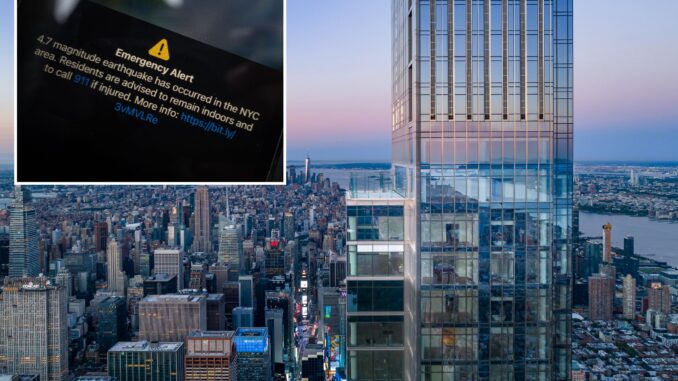
New Yorkers can breathe a sigh of relief after a surprising 4.8 magnitude earthquake jolted the city on Friday morning. While the tremors from New Jersey may have rattled a few nerves, experts assure that the Big Apple’s skyline remains standing strong.
Jesse Richins, lead seismic engineer at the New York City engineering firm MRCE, assured The Post that the city’s modern skyscrapers are indeed sturdy.
“Our tallest buildings here are relatively modern and have been designed for earthquakes of even greater shaking than this earthquake,” Richins said. “You may feel the shaking on the higher levels as the buildings sway, but those buildings are designed for that and should remain stable from this level of earthquake.”
Mobile users received an emergency alert following the earthquake on Friday. Getty Images
A digital ticker tape board at News Corp Headquarters displays the news of a 4.8-magnitude earthquake. Getty Images
However, Richins cautioned against complacency.
“Here in New York City, our most vulnerable structures are older infrastructure, retaining walls and unreinforced masonry buildings that were built before seismic considerations,” he said. “Considering our population and the economic importance of [New York], it’s critical that we continue to upgrade these structures so that we can remain resilient against the infrequent hazards of earthquakes.”
Richins pointed to historical precedent, citing earthquakes in 1737 and 1884.
“A magnitude 5.5 near the city would be expected to cause some damages to the oldest masonry buildings, retaining walls, structures near the shorelines and likely collapse a great number of brick chimneys,” he said.
Modern city structures are built to withstand the elements. NY Post
Moreover, the city’s tallest buildings are built to withstand smaller magnitude earthquakes. Paul Martinka
“Otherwise, a nearby earthquake around magnitude 6.0 to 6.5 would be about at the design level for modern structures, an earthquake of this magnitude nearby would likely cause widespread damages across New York City.”
Consulting engineer Robert Pyke echoed Richins’ sentiments, highlighting the importance of building codes.
“The national building codes provide for earthquake loadings everywhere,” Pyke said. “Just the level of loading that’s expected varies from place to place,” with the example of earthquakes being less common on the East Coast than in California.
Central Park Tower is one of the supertalls on Billionaires’ Row. NY Post
One57 with its characteristic curved top as seen from the Rockefeller Center Observation Deck. LightRocket via Getty Images
This image provided by US Geological Survey shows the epicenter of an earthquake on the East Coast of the US on Friday, April 5, 2024. AP
New York Post cover for April 6, 2024.
Pyke emphasized the need for long-term planning.
“In New York, earthquakes occur less frequently — they have to look at a longer period of time in order to get meaningful data.”
Real Estate – Latest NYC, US & Celebrity News



